
August 2019
AAVMC Summer Meeting Features Briefings from Federal Officials, Others
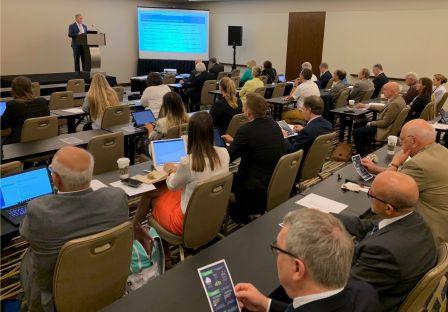
AAVMC President Dr. Michael Lairmore addresses Summer Meeting
Kicking off the event attended by about 50 deans and other guests, AAVMC President Dean Michael Lairmore outlined the progress of the AAVMC’s current strategic planning process. Lairmore said a series of concept papers exploring top issues in academic veterinary medicine had been developed by staff, board members and volunteers. The plan is on schedule for completion in early 2020.
A broader take on the future of academic veterinary medicine was then detailed by Texas A&M Dean Dr. Eleanor Green, who is leading the Veterinary Futures Commission. Comprised of representatives from the AAVMC, the AVMA and other profession leaders, the commission is nearing completion of a major report on the future of veterinary medicine. In draft phase, that report is expected to be broadly released throughout the profession in several months.
Dr. Scott Angle, Director of the National Institute of Food and Agriculture (NIFA) then spoke to the group about the status of NIFA’s relocation to Kansas City. The Trump administration’s decision to move NIFA and the Economic Research Service (ERS) to Kansas City generated a great deal of concern from Congress and a variety of stakeholders. While the move is on track for September 30 deadline, Angle said, only about 25% of the agency’s 700 employees are expected to make the move, precipitating a vast “brain drain” and loss of institutional knowledge. Angle said the agency is approaching the move as an “opportunity for change.”
Dr. Stephane Martinot, President of the European Association for Establishments of Veterinary Education (EAEVE), then outlined some of the current issues and operations of that group, which includes 96 members from 34 countries.
An update from the Foundation for Food and Agriculture Research (FFAR) was then shared by Executive Director Dr. Sally Rockey. Created by the 2014 Farm Bill and initially funded with $200 million, FFAR operates as a public/private partnership that funds promising research in food and agriculture. In their roughly three years of operations, FFAR has funded more than 100 proposals and established relationships with 344 funding partners. FFAR, along with the AAVMC, offers a summer fellowship program for veterinary students called the FFAR Vet Fellows. These fellowships allow veterinary students to pursue research at the intersection of global food security and sustainable animal production.
Dr. Douglas L. Steele, Vice President for Food, Agriculture and Natural Resources with the Association of Public and Land-Grant Universities (APLU), presented an overview of that organization’s current operations and priorities. The AAVMC has recently partnered with APLU on the establishment of the National Institute for Antimicrobial Resistance Research and Education (NIAMRE).
The meeting wrapped up with questions and comments from the audience following a presentation on the Veterinary Business Management Association by President Ricky Walther and Vice President Emily Farmer.
AAVMC’s DiVersity Matters Program Receives a National Award of Excellence From 44,000 Member ASAE
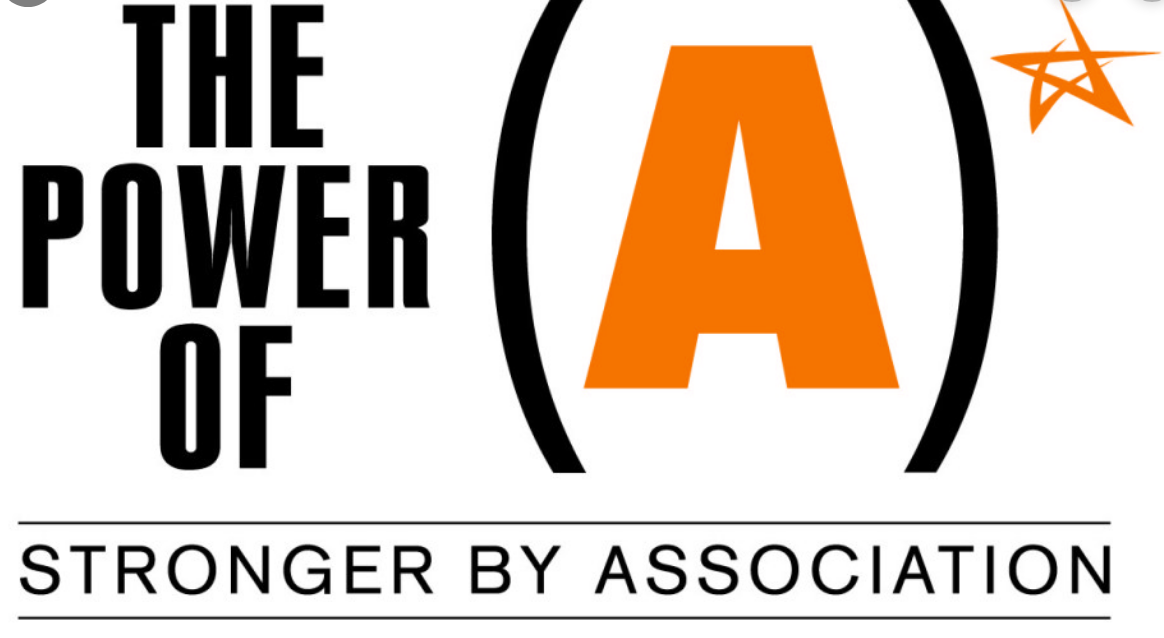 The AAVMC recently received a national 2019 Power of A Silver Award from the American Society of Association Executives (ASAE) for its DiVersity Matters program. The ASAE includes 44,000 members and 7,400 member organizations.
The AAVMC recently received a national 2019 Power of A Silver Award from the American Society of Association Executives (ASAE) for its DiVersity Matters program. The ASAE includes 44,000 members and 7,400 member organizations.The AAVMC launched DiVersity Matters in 2005, partly in response to a widely acknowledged lack of diversity in veterinary medicine. Several years ago, a leading magazine characterized veterinary medicine as the “whitest” profession.
DiVersity Matters works to help member institutions recruit and retain underrepresented persons as students, faculty and staff members. The program also works to share best practices and inspire and recognize programs in member institutions and develop broader awareness throughout the profession and society about the need and the value of creating diverse and inclusive environments within the profession.
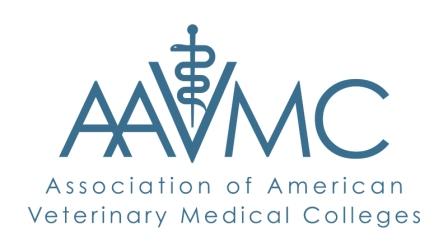 “For 14 years now, our staff has diligently worked to advance diversity and inclusion, with an enterprise-wide emphasis, creative programing and leading initiatives,” said AAVMC CEO Dr. Andrew T. Maccabe. “We are passionate about this work and it’s gratifying to earn this recognition, which also honors the work being accomplished by countless volunteers at our member institutions.”
“For 14 years now, our staff has diligently worked to advance diversity and inclusion, with an enterprise-wide emphasis, creative programing and leading initiatives,” said AAVMC CEO Dr. Andrew T. Maccabe. “We are passionate about this work and it’s gratifying to earn this recognition, which also honors the work being accomplished by countless volunteers at our member institutions.”Led by the AAVMC’s Senior Director for Institutional Research and Diversity Dr. Lisa Greenhill, DiVersity Matters has increased awareness and helped facilitate a substantial increase in the number of racial and ethnic minorities entering the profession. At the launch of program, there were 951 students of color in the colleges. Presently, there are 2,614 students of color in the colleges—a 275 percent increase.
There is a modest increase in the percentage of racial/ethnic minority tenure track faculty at the U.S. colleges, as well as an increase in the number of women administrators and research faculty.
In addition, most of the colleges now have a dedicated staff person responsible for diversity programming for students and faculty. Many of the colleges now offer curricula on diversity, inclusion, cultural competence and humility, and several schools have mandatory requirements in this area of coursework.
Others have developed certificate programs or sponsor students and faculty to participate in the Purdue University Certificate in Diversity and Inclusion in Veterinary Medicine program (the AAVMC sponsors scholarships for members wishing to enroll faculty and students in this program). Many colleges also use the AAVMC’s podcast, Diversity and Inclusion on Air, to supplement relevant content on campus.
Finally, AAVMC climate studies have encouraged colleges to provide additional resources into student organizations and climate-enhancing programming on campus.
ASAE’s Power of A Awards, the industry’s highest honor, recognize the association community’s valuable contributions on the local, national and global levels. The Power of A Awards reward the outstanding accomplishments of associations and industry professionals who work tirelessly to solve problems, and strengthen lives, the workforce, the economy, and the world.
The Power of A was created in 2009 as a campaign to educate the presidential administration and Congress about associations, their role in society, and the expertise they lend to the policy-making process.
Veterinary Debt Initiative Introduces Tuition Infographic
The Veterinary Debt Initiative (VDI) introduced an infographic during the recent AVMA meeting in Washington, D.C. focused on tuition and the cost of education. The publication is designed to help students and other stakeholders understand some of the forces affecting the cost of veterinary college tuition, how those costs are formulated and share other fiscal and budgetary information. The VDI, which includes representatives from the AAVMC, the AVMA, and the Veterinary Medical Association Executives (VMAE) is working to help veterinarians thrive in rewarding and financially sustainable careers through education, advocacy, research and outreach.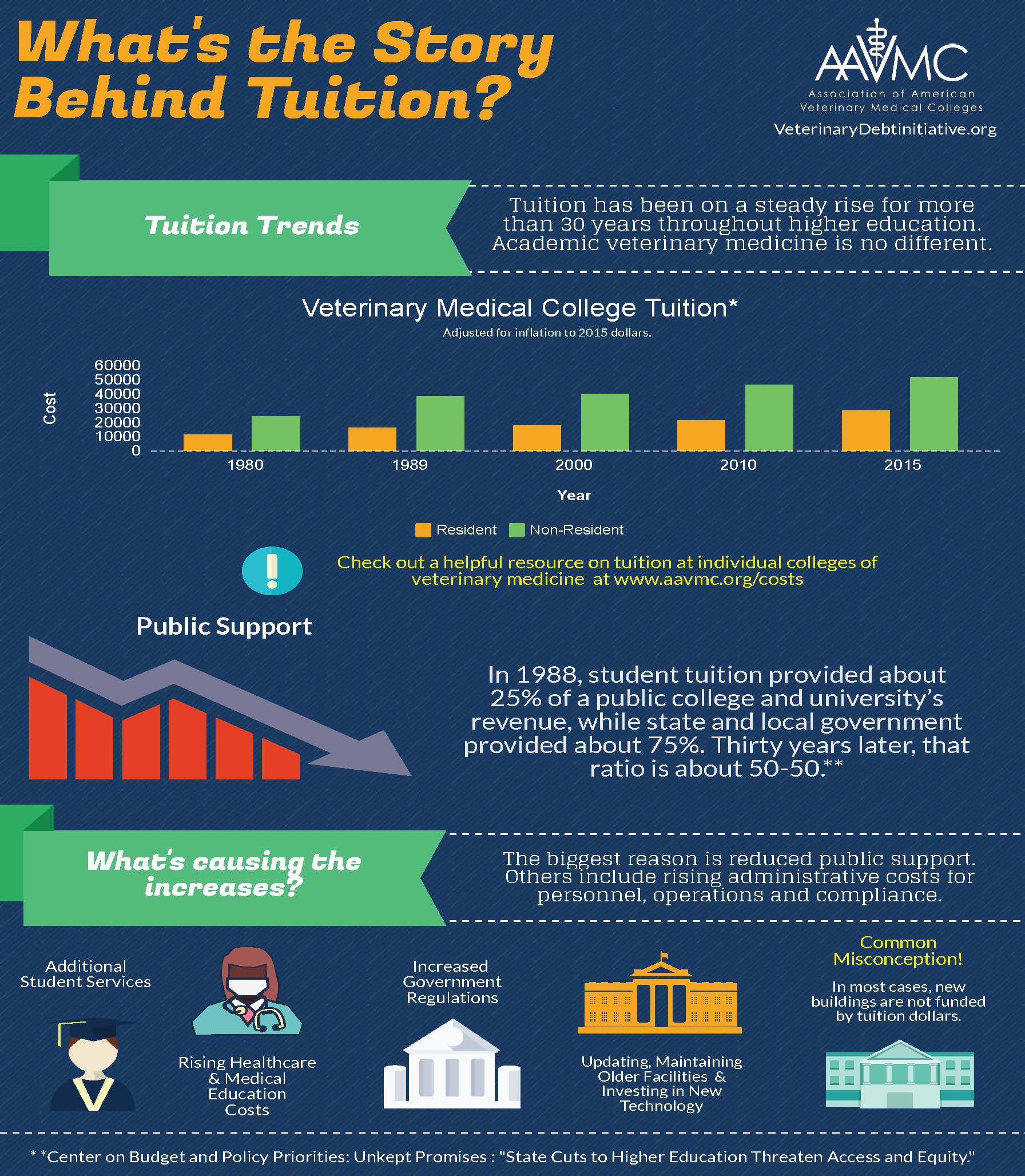
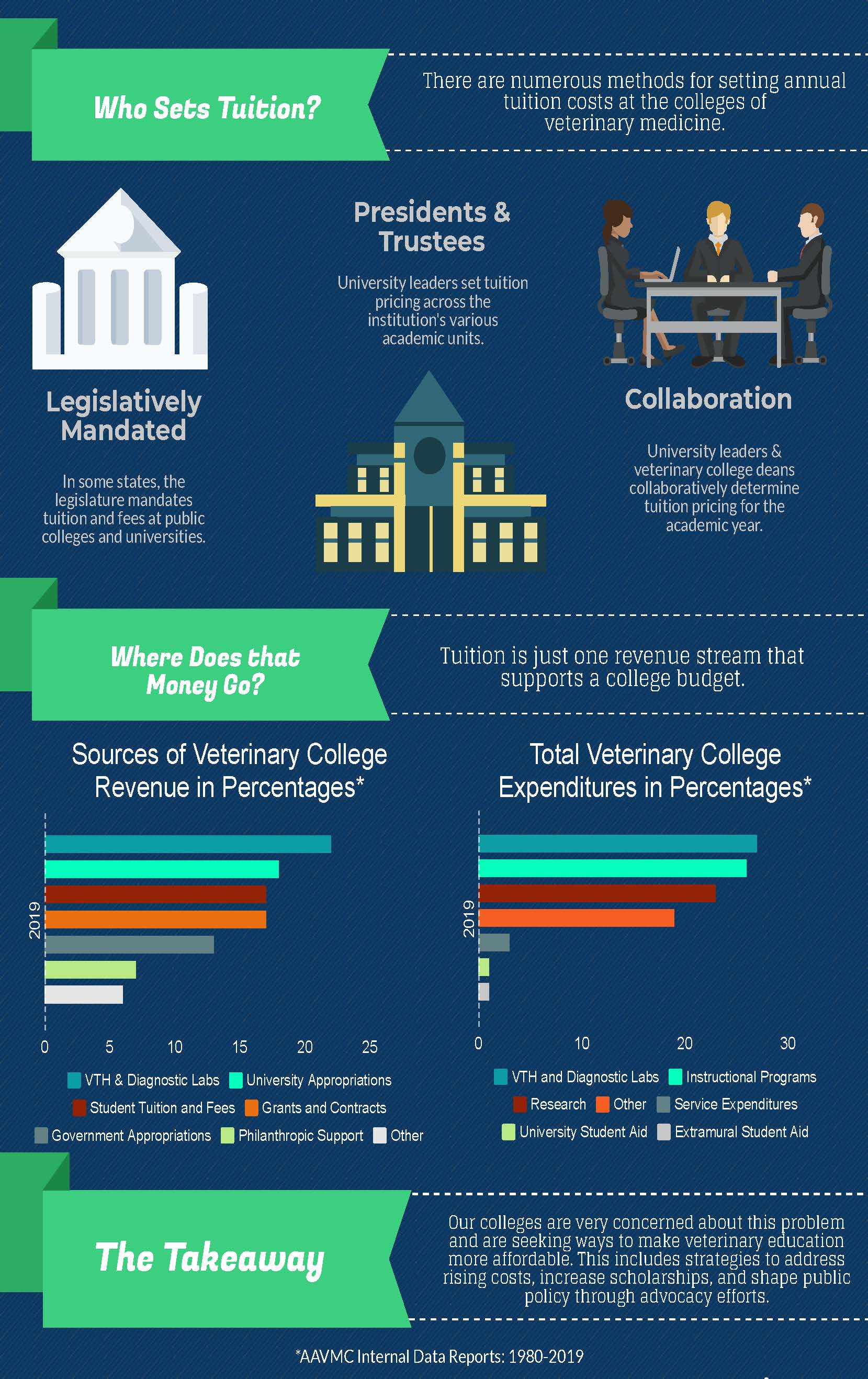
National Veterinary Scholars Symposium Highlights Student Research and Careers
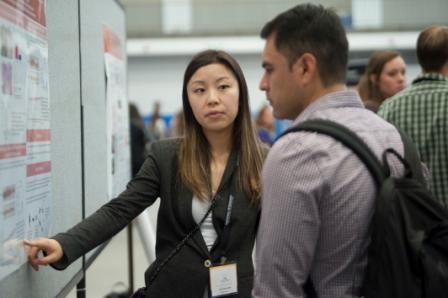
Photo credit: Shawn Kelly
Attendees included 600 veterinary medical students from more than 40 schools who are involved in research, faculty members/mentors and distinguished researchers from academia, industry and government.
The symposium, which is widely recognized as the premiere national meeting for veterinary student research, is the culmination of many student summer research programs, including the Boehringer Ingelheim Veterinary Scholars Program, multiple programs funded by the National Institutes of Health (NIH), the Foundation for Food and Agriculture Research (FFAR) and the colleges of veterinary medicine. The symposium highlights the ways veterinary scientists advance basic and applied research to support global health and serves as an incubator for many students who pursue careers in scientific research.
First- or second-year veterinary medical students who were mentored by university faculty members in established laboratories presented scientific posters on their hypothesis-driven research projects.
Themed “Engaging Veterinarians to Advance Animal and Human Health,” the symposium was presented with support from Boehringer Ingelheim Animal Health, the NIH, the Burroughs Wellcome Fund, the American Veterinary Medical Association/American Veterinary Medical Foundation and the AAVMC.
Dr. M. Sawkat Anwer, Distinguished Professor and Associate Dean for Research and Graduate Studies at the Cummings School, described the symposium as highlighting “the importance of collaborative research conducted by veterinarians, physicians and basic scientists,” adding that, “Such collaborations are essential to understanding, preventing and treating diseases affecting animals as well as humans.”
The symposium provided students with exposure to a variety of topics at the intersection of animal and human health through presentations and panel discussions. Breakout sessions highlighted advances in emergency and critical care, antimicrobial resistance, regenerative medicine, oncology, and infectious diseases and pathways to research career development.
Distinguished speakers presented on topics that ranged from “Vaccines and Immunotherapeutics” to “Understanding Cancer Biology” and “How Re-engineered Antibodies from Camelids May be the Antibody Therapeutics of the Future.”
Sample student research topics included: defining causes of intra-mammary infection in dairy cattle using a novel sampling technique; the use of MR spectroscopy to differentiate canine brain masses; development of a laser scalpel neurosurgical approach to treat focal neocortical epilepsy; and defining causes of intra-mammary infection in dairy cattle using a novel sampling technique.
Networking opportunities included a closing reception followed by a banquet.
Faculty Fellows Nomination Period Opens
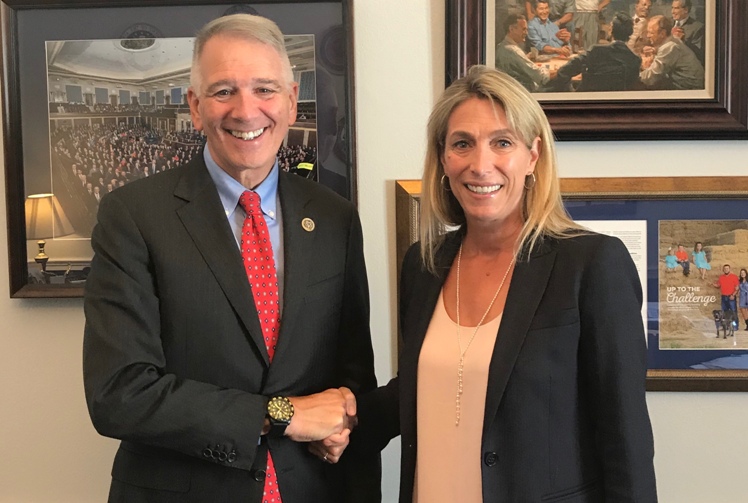
Former Fellow Dr. Christine Johnson (right) with Congressman Ralph Abraham (R-LA), a veterinarian and physician.
The program offers faculty members at AAVMC member institutions an experiential opportunity to learn about how federal government policies affect academic veterinary medicine.
The AAVMC initiated the program in 2015 to bring faculty members to Washington D.C. to develop leadership skills in the advocacy arena, explore the impact of public policy decisions on the profession, and gain knowledge and experience with the legislative and regulatory process at the federal level.
The fellowship is also designed to help participants use their knowledge and experience to work as leaders in advocacy and public policy at their home institutions.
Fellows can also network with each other and with various mentors from academic, industry and government backgrounds.
Fellowships last a minimum of six weeks and a maximum of eight weeks, with dates determined in consultation with the Director of Governmental Affairs based upon the issues to be studied, the congressional calendar, and the availability of the fellow(s). Although the preference is for the fellowship to occur during a time when Congress is in session, the actual program timelines are somewhat flexible and the AAVMC will work with candidates in order to incorporate a time frame that works best with their schedule. A maximum of two fellows will be chosen for the year.
Nominees must submit a package of no more than five pages, to include an abbreviated CV highlighting work that is relevant to this program, a letter outlining their reasons for applying for the program and what they would like to gain from the program, and any other supporting documents.
Fellows will receive a stipend of $10,000 from the AAVMC to cover expenses, but will remain on their employer’s payroll, subject to university policies. The program is open to all AAVMC member institutions.
Past fellows have described their fellowships as enriching experiences. Read about a past fellow.
Please submit nominations and supporting documents electronically to awards@aavmc.org.
Questions about the program can be directed to Kevin Cain, Director of Governmental Affairs at kcain@aavmc.org.
Why Drop the GRE? A Q&A with the AAVMC’s Dr. Lisa Greenhill
 A growing number of graduate and professional programs are moving away from requiring the Graduate Record Exam (GRE) and veterinary medicine is no different. In recent years, several U.S. colleges of veterinary medicine discontinued requiring GRE score submission as a part of the application process. It is expected that more schools will follow this trend in the coming years. There are several reasons why there is such a shift away from using the test in veterinary admissions. This Q&A with AAVMC Senior Director for Institutional Research and Diversity Dr. Lisa Greenhill shares some key insights.
A growing number of graduate and professional programs are moving away from requiring the Graduate Record Exam (GRE) and veterinary medicine is no different. In recent years, several U.S. colleges of veterinary medicine discontinued requiring GRE score submission as a part of the application process. It is expected that more schools will follow this trend in the coming years. There are several reasons why there is such a shift away from using the test in veterinary admissions. This Q&A with AAVMC Senior Director for Institutional Research and Diversity Dr. Lisa Greenhill shares some key insights.After so many years of using the GRE as a predictor of veterinary student success, why are some colleges no longer using the test?
It is all a part of the feedback loop. Colleges regularly review their admissions policies and practices to determine efficacy; the data are used to improve the process. What some colleges are finding is that although there may be a positive correlation between applicants’ scores and subsequent performance in the DVM program, the GRE may not be as strongly predictive of performance as other elements of the application such as overall undergraduate academic performance or pre-requisite grades. The test scores do not necessarily give more meaningful data than other pieces of data in the application.
If it does provide additional information for admissions decision making, why drop the test?
For some schools, it is a question of ethics and burden. If your data show that other elements of the admissions application give more meaningful data, then it becomes hard to justify requiring applicants to bear the cost of GRE testing. The GRE costs $150, and on average veterinary school applicants take the test twice. Guided preparation courses can cost between $400 and $2,000 and run several weeks. For students studying on their own, there is still potentially a loss of productivity in terms of work, community service and academic performance. As more applicants apply to more schools, many are also having to absorb the additional cost of paying for score submissions. For prospective students coming from low income backgrounds, the GRE and its surrounding expenses present a real burden, especially if the test is not the best predictor of their performance. All told, the GRE, while still a valuable tool, can be a costly tool that has colleges questioning the return on investment.
What about research on testing bias among underrepresented groups?
According to ETS, the company that develops and administers the GRE, efforts are made to create bias-free tests. That said, differences in baseline scores across historically underrepresented groups persist. Additionally, research exploring stereotype threat and test anxiety suggest that these are very real barriers to higher scores on tests like the GRE. Such findings, coupled with ETS’s own acknowledgement about scores across groups provide more than enough rationale for AAVMC’s promotion of holistic admissions efforts that evaluate the whole applicant without overemphasizing scores and grades.
What does eliminating the GRE mean for applicants?
Eliminating the GRE as an application requirement can increase access to the application process. Roughly 30% of our applicant pool are from low-income backgrounds and/or first-generation backgrounds. On average, applicants spend between $1,500 to $2,000 applying to veterinary school; eliminating the GRE can reduce that cost burden by several hundred dollars. As we think about costs, accessibility and equity in admissions, the elimination of the GRE application requirement in favor of more reliable evaluation tools can be a significant improvement on multiple fronts.
When talking to applicants, my colleagues at AAVMC always encourage applicants to select where to apply strategically. I think that for applicants who are worried about testing (the costs, test anxiety, equity issues in scoring) whether a college requires the GRE is another data point in the calculus of determining where to apply. Colleges that eliminate the requirement tend to see a small bump in the number of applicants, but over time those numbers tend to level out, so we do not necessarily see applicants flocking to institutions with the impression that eliminating the GRE makes admission less competitive.
What about those colleges that still require the GRE?
Each college is unique, and their data may show stronger performance predictability, justifying keeping the GRE on as a requirement. All colleges are concerned about affordability and accessibility of the DVM program, and AAVMC’s research on the applicant pool is raising greater awareness about these same issues specifically in the context of the admissions process. I think we will see those colleges retaining the GRE as an application requirement evolve in how they use GRE score data, and that they will continue to question how the use of the GRE fits into their larger admissions process. I also think they will look to adequately communicate to prospective applicants why they continue to use the test.
What does the future of the GRE look like?
Nationally, there is a lot of emerging research about the use of standardized testing in admissions across the higher education spectrum. The trends suggest that while helpful, the GRE is not essential to determining whether the applicant can be successful in the academic program and that its use can be de- emphasized in the admissions process. I think that we will see more programs drop the GRE requirement or become “test-optional.” This latter option may be meaningful for applicants who are really concerned about other aspects of their application and want to submit scores that might make them appear more competitive.
Currently, the GRE, and other tests like it, are still largely required by graduate and professional programs in the US and abroad. I predict that how the scores are used will continue to evolve based on the research. I predict that we may also see ETS, the company that develops and administers the GRE, look to improving the test’s reliability.
JVME Ramps Up to Publish Six Editions Per Year
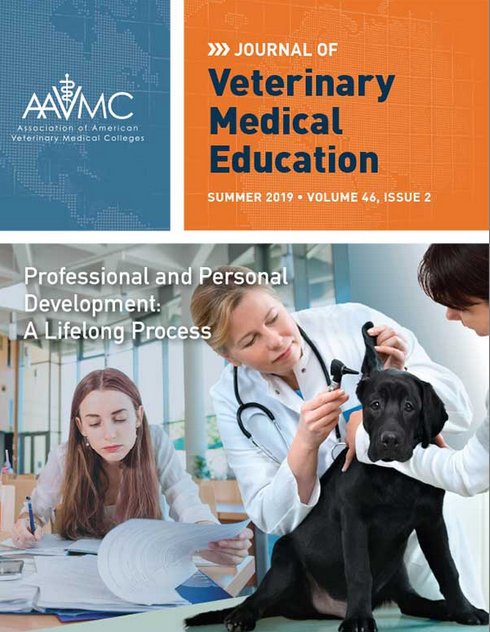 The Journal of Veterinary Medical Education is moving from a quarterly publication schedule to a bi-monthly production schedule effective with Volume 47:1, which is scheduled for distribution in February 2020.
The Journal of Veterinary Medical Education is moving from a quarterly publication schedule to a bi-monthly production schedule effective with Volume 47:1, which is scheduled for distribution in February 2020. Additional production resources are also being acquired through the University of Toronto Press to increase copy-editing capacity. Both measures are being undertaken to substantially decrease the time between manuscript acceptance and appearance in print, according to JVME Editor-in-Chief Dr. Daryl Buss.
“The success of the Journal of Veterinary Medical Education has unfortunately resulted in an unacceptably long delay between acceptance of a manuscript and its appearance in print, said Buss. “I am delighted that the AAVMC Board of Directors has supported these measures that are critical to resolving this problem. I look forward to working with the Board of Directors as we develop and implement further strategies to keep the JVME at the forefront of veterinary medical education.”
Wisconsin Faculty Member Leading 130,000 Member FASEB
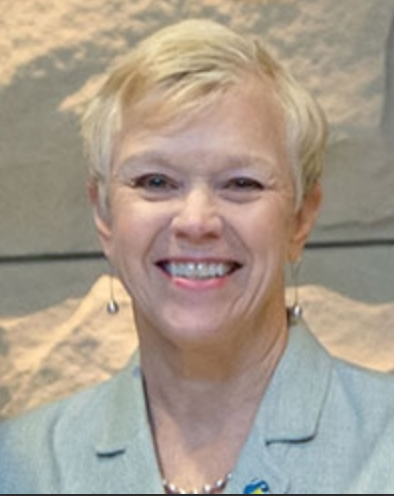 A faculty member at the University of Wisconsin School of Veterinary Medicine has become the first veterinary college faculty member to ever lead the Federation of Experimental Societies for Experimental Biology (FASEB). Dr. Hannah Carey, a professor of comparative biosciences, assumed the presidency of the massive 130,000-member scientific society that represents 30 scientific societies on July 12. Click here to read a detailed Q&A with Dr. Carey.
A faculty member at the University of Wisconsin School of Veterinary Medicine has become the first veterinary college faculty member to ever lead the Federation of Experimental Societies for Experimental Biology (FASEB). Dr. Hannah Carey, a professor of comparative biosciences, assumed the presidency of the massive 130,000-member scientific society that represents 30 scientific societies on July 12. Click here to read a detailed Q&A with Dr. Carey. “FASEB is an important force for the advancement of scientific research and discovery in society and we congratulate Dr. Carey for this achievement,” said University of Wisconsin School of Veterinary Medicine Dean and AAVMC President-Elect Dr. Mark Markel. “Her election and service is a reflection of her extraordinary talent, dedication and capacity. And it’s a significant honor and opportunity for the profession of veterinary medicine as well.”
In the News
Why Dogs Now Play a Big Role in Human Cancer ResearchWired Magazine
This Algorithm is Predicting Where a Deadly Pig Virus Will Pop Up Next
PBS
Scientists Develop 3D Printed Pill that Samples Bacteria Found in the Gut
Medical News
An Untapped Pipeline for Veterinary Schools
JAVMA News
Genetic Similarities of Osteosarcoma Between Dogs and Children
Medicine News Line
NIH Renews Veterinary Researchers’ $2M Grant to Study Hepatitis E
HEP
After FDA Warning About Grain-free Pet Food, What’s Safe to Feed Our Pets?
NBC News
Oregon Tackles the Veterinary Suicide Crisis, Starting With the Stigma
The Oregonian
Penn Vet to Run Cannabis Clinical Trial for Arthritic Dogs
dvm360
AU Vet School Develops Treatment for Neurological Disease
Times Free Press
U of M Provides Mental Health and Stress Support for Minnesota Farmers
Agweek
Systems Project Examines Sustainability of Iowa Cow/Calf Sector
Feedstuffs
ASCO Makes $5 Million Texas Tech Amarillo Vet School Contribution
Amarillo Globe News
$24M in Funding Announced for 3 U of Sask-led Agriculture Research Projects
Yahoo News Canada
Health Problems of Short-Muzzled Dogs Widely Unknown to Owners
Veterinary Practice News
New RCVS President Calls for Profession to Embrace Diversity
Vet Times
New Approach to Vaccine Development Could Successfully Eliminate Other Pathogens
The Pig Site
Leading Experts Call for Action to Address Chronic Wasting Disease
USAgnet
AAVMC Issues Call for Proposals
Veterinary Practice News
RUSVM Supports St. Kitts’ First Animal Rescue Center
Veterinary Practice News
Listeria May be Serious Miscarriage Threat in Early Pregnancy
Food Poisoning Bulletin
BRSV Prevention Topic of Auburn Research
Feedstuffs
A Secret Sense
Proto Magazine
Knockout Mice are Guide to New Genes for Eye and Skin Disorders
Science Magazine
Dr. John Howe Elected President Of AVMA
Paulick Report
Boehringer Ingelheim Awards Honor Emerging Veterinary Talent
Veterinary Practice News
From Our Members
CEPI Awards Funding Agreement Worth up to $9.5 Million to Colorado State University to Develop a Human Vaccine against Rift Valley FeverColorado State/UC Davis
Multi-disciplinary Team at Cornell Diagnoses and Treats Dog’s Rare, Dangerous Pregnancy Complication
Cornell University
CVM Researcher Awarded Grant for Innovative Disease Work
NC State University
Giraffes Under Parasitic Attack?
Tufts University
Milo Celebrates 6 Months Post-Surgery
Oklahoma State
Equine Encephalitis Detection Highlights Need to Protect Horses, People
University of Wisconsin
To see a news feed featuring breaking news from our member institutions, please click here.
“Like” us on Facebook or follow us on Twitter:




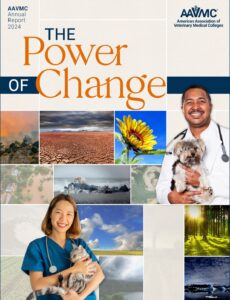
SHARE